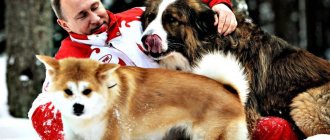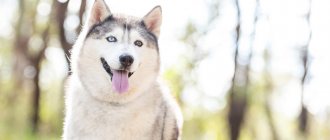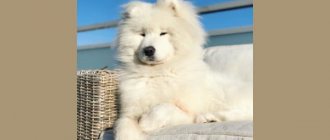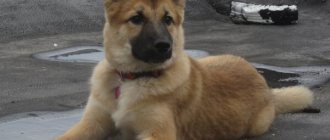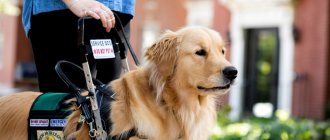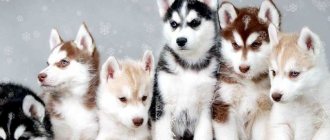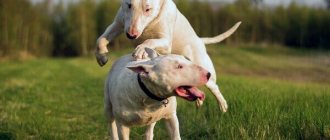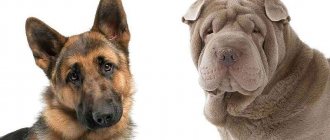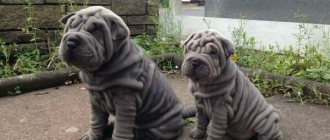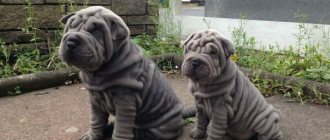When talking about sled dogs, a person imagines harsh snowy northern landscapes, teams and sleighs. The furry “horses” are distinguished by great physical strength and endurance. They easily tolerate low temperatures, harsh climates (Alaska, Siberia, Kamchatka, etc.) and can pull a load for hours without rest. Thanks to their physical strength, they can even pull watercraft.
A few centuries ago, dogs were strictly divided according to their purpose: hunting, sledding, guarding, etc. Nowadays, most animals are becoming pets. Lovers of strong purebred dogs prefer to choose powerful, shaggy sled dogs. Their breeding outside the northern regions is not yet very common. Most often in the city you can see malamutes or huskies.
Purpose
Four-legged friends with blue eyes first “came” to America from the North.
These dogs are sled dogs, accustomed to being in a large harness, covering long distances and being in wide open spaces. These are strong dogs, and their habits retain much of the wolf. They are brave and intelligent hunters, get along well in a pack and are very clean. In an urban environment, huskies do not live the happiest lives; they are isolated from other dogs, and few owners can provide them with sufficient physical activity in the city.
Sled breed
Many varieties of huskies, like malamutes or wolfdogs and other breeds of dogs, are used as traction force for transporting goods, carts, boats, and people. They are capable of covering about 50 km a day (with rest stops, of course) and reaching a speed of 12 km/h.
The sled is convenient for traveling over long distances in the Siberian and northern snowy expanses, as these dogs are hardy and loyal. In the evenings, after a long journey, they warm their owners.
Sled dogs are known for the feat of leader Balto, who traveled more than 2 thousand kilometers to deliver medicine against diphtheria in Alaska.
The largest recorded distance involving sledded huskies is 10,000 km.
IMPORTANT! Harness riding is their true nature and they are at their best when they live in the right environment.
Hunter
Similar huskies are often trained for hunting.
These breeds should not be confused - they are similar only in appearance, their characters and inner nature are very different. Huskies are less suitable for hunting. Their character is very willful. In Siberia, these pets often played the role of a hunter and brought small and medium-sized game. However, rather at their own request than at the command of the owner. It is their nature to be strong and resistant to harsh weather conditions. They are brave and are not afraid to attack an animal larger than themselves. In addition, they have a very keen sense of smell and determination - qualities that help pets find fresh tracks of roe deer or deer, as well as holes of small game. But still, initially they are not hunters.
Security guard
For the Husky as a guard, it is important to “outline” his protection zone. In Siberia, these dogs were in sleds and could serve as guards at a rest stop.
However, two teams can be at enmity with each other, so it is necessary to teach the dog boundaries, and due to its willfulness, such a dog on a leash will feel betrayal by the owner and punishment. This will not have the best effect on her security abilities. At the same time, it is necessary to teach the dog to react friendly to strangers and other animals.
Defender
This breed is difficult to train with aggressive measures. The dog wants to feel the respect of its owner, and then it may respect him and accept him as a leader. Therefore, in a conflict situation, the husky will not fly to protect the owner or his property, she will act according to her own ideas about the situation.
ATTENTION! Coercion will only discourage the dog from being a protector.
Despite the fact that in Siberia huskies can be versatile and perform different roles, there they are in their natural environment, familiar to them, and often without a leash when not in harness. But in other conditions, when a husky lives alone (without other members of the pack), it is difficult to predict its character. You can only slightly correct the behavior with persistent training, greater activity and expressions of respect.
Sports with husky
Siberian Huskies are great for sledding. There are several varieties, which are divided into snow and non-snow disciplines.
Snow disciplines:
- Pulka is a husky sled race. There are from 1 to 4 dogs in the team.
- Skijoring - the skier is directly connected by a rope to the dog.
Snowless disciplines:
- Canicross is like skijoring, only without skis and snow. Runner and pet on a zip line.
- Bike joring - a dog pulls an athlete on a bicycle.
- Karting - a dog pulls a special kart with a driver.
- Scooting - a team of dogs pulls a scooter.
Sled sport is the best use for these dogs. They show good results in sports competitions.
IMPORTANT! Exercising can ruin your pet's health in warm climates. It is better to refrain from training at temperatures above 16 degrees plus.
Instead of an epilogue
Sled dogs have always been characterized by an increased level of conditioning, activity, strength and endurance, which indicates a particular degree of popularity among professional dog breeders. In addition to their aesthetic function, they will perfectly cope with the role of a companion and friend for their owner. Articles can also be a family pet, but we must not forget that these are primarily service dogs, designed to perform certain work for the owner. Today, the world knows about two dozen of the most common breeds of northern dogs, but not all of them can cope with the driving function.
History of sled sport
Sled dog racing was first mentioned in 1850 - travelers competed on the road between the cities of St. Paul (USA) and Winnipeg (Canada). Another recorded evidence of such competitions dates back to 1886, when they were held as part of the Winter Carnival in the same St. Paul.
However, the real origin of sled sport occurred during the “gold rush” in the Canadian Yukon and American Alaska. Thousands of seekers flooded the region in search of the precious metal, and in the snowy expanses, dog sleds became the most efficient means of transportation over long distances. A class of professional drivers (mushers) was formed, delivering supplies to remote mines. Competition between seekers also contributed to the growth of the competitive spirit.
The center of the development of sled dog racing was the American city of Nome in Alaska. It was here in 1907 that the first full-fledged sledding competitions called All Alaska Sweepstakes took place. Scottish-born musher Alexander Allan, also known as Scotty Allan, played a major role in organizing the competition. Another famous driver in Nome would be Leonard Seppala, later a silver medalist in the 3rd Winter Olympics in Lake Placid in 1932.
The popularization of sled sport was greatly facilitated by the story of Balto, the leader of the team that delivered anti-diphtheria serum to epidemic-stricken Nome in 1925. The story of a husky dog that helped musher Gunnar Kaasen find his way in a snowstorm received enormous resonance in the media. The team made several tours throughout the United States, and Balto himself became a national hero - a monument was erected to him in New York. In memory of this Race of Mercy, competitions began to be held regularly in Nome, attracting many fans of both sledding sports in general and the story of the heroic dog in particular.
Although dog sledding was originally popular in North America, over time it began to gain fans in other countries. The first European state to have its own professional competitions was Norway. This was facilitated by the history of local explorers of the Far North, Rasmussen and Nansen, who used dog sleds in their travels. At the 1952 Olympic Games in Oslo, sledding was presented in the form of demonstration competitions. Gradually, their own competitions began to be held in Austria, France, Switzerland and other European countries. Already in the 70s of the 20th century, sled dog racing clubs were registered almost throughout Europe.
An important stage was the creation in 1983 of the European Sled Racing Association (ESDRA), under the auspices of which today the European Championship and Cup are held among 22 countries. In 1992, national sled sport federations from all 5 continents united to form the International Federation (IFSS), which holds the Cup and the World Championships, as well as representing sled racing in the Olympic Committee.
In the USSR, dog sled racing was poorly represented - competitions were held as part of national northern holidays, and the media covered such events only at the regional level. The situation changed in 1990, when the first sports race “Beringia” was held in Kamchatka, 250 km long. A year later, it competed with the 1,920-kilometer Chukotka Nadezhda highway, which connected the Russian Anadyr and the American Nome, thus becoming the first international competition in Russia.
In the mid-90s, sledding was carried out in Central Russia on the Moskovia track, which connected Moscow and St. Petersburg. And in 1996, domestic athletes organized the first Russian Sled Dog Racing Federation, which joined ESDRA and IFSS. Its successor in 2003 was the All-Russian Association of Equestrian Sports (BAEC), which existed until 2011. For 3 years after this, the development of sled sport in Russia was carried out thanks to the efforts of regional associations and clubs, many of which were represented at the international level. In 2014, 23 of them united under the leadership of the Russian Sled Sports Federation (FES). Domestic mushers actively participate in international competitions, including taking prizes at European and world championships.
What are sled dogs trained for?
Physical activity is necessary for sled dogs, and its absence can result in uncontrollable behavior of an energetic pet and significant destruction in the home. It is for this reason that they prefer to keep sled dogs in suburban conditions.
To train sled dogs, harness running is used, which is divided into several varieties:
- skijoring - towing a skier with one or two dogs;
- Skipulling is the towing of a special projectile with a calculated weight (bullets), to which the skier is connected by a cable. A team consists of 1 to 3 dogs;
- sledding is a high-speed sled race with up to 6 dogs harnessed in pairs. The speed of individual crews can reach 50 km/h.
In the absence of snow cover, sled dogs are involved in dryland - sledding sport on the ground. There are:
- canicross - the dog acts as a tow vehicle for a person running over rough terrain, setting the pace of the run;
- bikejoring - towing a cyclist with 1-2 dogs;
- dog-karting - towing a cart (kart) with a seated person;
- dog scootering - towing a person on a scooter.
Training in sledding sports begins at 4–5 months of age, teaching the puppy to follow in front of a person, tow a feasible load, and also carry out voice commands that reflect the direction of movement (“Forward!”, “Right!”, “Left!”, “Stop!” "). In the future, when the puppy joins the team, they ensure its well-coordinated interaction with other dogs. Thus, the training of a sled dog is based on individual training with the owner, as well as further training by imitation when included in the team. Dogs over 12 months of age are allowed to compete.
Sled dogs can also take part in other sports, such as agility, freestyle and many others. The main thing is to satisfy the dog's need for physical activity.
Photo gallery: sports for sled dogs
Skijoring - towing a skier
Canicross - running with a dog over rough terrain
Bikejoring - towing a cyclist
Sliding - high-speed harness racing
Northern sled dogs are primitive breeds characterized by minimal human participation in their development. The main purpose of northern sled dogs is to tow loads in extreme weather conditions, so their inherent qualities are strength, endurance, vitality and energy.
When keeping sled dogs as pets, it is extremely important to provide them with the necessary physical activity, this will strengthen the bond between the pet and the owner, and will help to avoid problems with the dog’s health and behavior
Difficulty of choice
The choice of a sled puppy must follow special rules. First of all, the puppy should be very active from childhood, which will indicate his predisposition to his future purpose. However, you should not pay attention to the baby who has just woken up - naturally, after sleep, due to his age, he will still be quite lethargic. Also, activity may appear when a new person appears - northern dogs are very curious and should themselves strive to meet new people. At the same time, it is worth finding out about the puppy’s appetite, for which it is necessary to visit the future pet shortly before the feeding process. You need to understand how the dog reacts to food being served - whether it approaches the bowl sluggishly or impatiently awaits its portion, actively wagging its tail. A separate look should be paid to physical characteristics - the sled dog should not have any birth defects, from the condition of the heart muscle to the presence of congenital lameness.
IMPORTANT! Experts note that by the age of two months, a northern puppy will have more or less developed the basics of its character, so you need to choose the bravest one.
The check is very simple: you need to approach the group and extend your hand in their direction - the little ones will immediately start running away, and the braver puppies will come closer to find out why they are holding out their hand. Any fear at this age for a sled dog is considered a negative reaction, which means the possibility of behavioral problems in the future. Another way: you need to take all the puppies from the mother and place them at some distance from each other. The mother will approach first the puppy that she considers the most promising.
A healthy puppy always visually looks very well-groomed, he has no discharge in the ears or near the eyes, his bite is even, and he has an excellent appetite. A constantly moist and cool nose, a pronounced pink shine of the mucous membranes, a belly without any deformations, as well as a generally slender physique - these are signs of health in an animal. If a dog is bred for exhibition work or breeding, then higher demands are placed on it. As a rule, for these purposes you just need to contact a nursery with a long and excellent reputation - there the specialists themselves will select the right individual and prepare the necessary documents. But even in this case, the future breeder needs to carefully trace the entire pedigree of the puppy.
IMPORTANT! It is worth remembering that even champion parents have defective offspring, so it is impossible to do without an independent examination of the animal.
Separately, you need to talk with the breeder himself - a good professional is always able to answer any tricky question, and his working documentation should not arouse any suspicion.
Nordic sled dogs
Sled dogs are animals that humans use as traction force to transport cargo and people. For this purpose, dogs have been exploited for more than 7 thousand years. Conquest of the earth's poles at the beginning of the 20th century. happened precisely on such sleds.
Alaskan Malamute
It is considered by scientists to be one of the oldest breeds bred by Alaskan Eskimos for draft work. One of the dog's ancestors is considered to be the polar wolf. The name of the breed comes from the name of the tribe that bred them - “Malemute”. They were used to transport goods and people, and less often for home security.
Surprisingly, Alaskan Malamutes cannot bark. Their beautiful thick coat is wolf-colored and has a dense undercoat. The weight of an adult varies between 32-37 kilograms
When keeping an animal, it is important to provide it with long walks and moderate physical activity every day.
All about the Alaskan Malamute breed in a full review.
Samoyed
The full name of this breed is Samoyed, but most people know it simply as “Samoyed”. Northern sled dogs of the Samoyed breed resemble kind fairy-tale bears, but behind this “soft” appearance lies power and endurance. The long fluffy coat and snow-white color have made Samoyeds popular among the population of many countries. The weight of males varies between 20-32 kg, females - 15-21 kg. The typical height for a female is 47-54 cm, for a male – 54-62 cm.
Samoyeds are characterized by cheerfulness and friendliness, they are smart, but somewhat stubborn. They are devoted to their owner and can play with him all day long, not only as a puppy, but also in adulthood.
The Samoyed owner should provide his pet with long walks and light exercise every day. The coat requires daily brushing. Dogs easily adapt to changes in temperature, so they can be kept both in an apartment and in the private sector.
Find out more about the Samoyed Laika dog breed.
Siberian Husky
Dogs of this breed look very similar to Malamute, but are inferior to it in build and height. Siberian Huskies are considered breed dogs, but their ancestors were exploited by the Eskimos for a long time in hunting, herding herds and transporting heavy loads. The name of the breed originated from the word “Eski” - that’s what foreigners called Eskimos. The main purpose of the breed is to transport light objects over long distances, since these animals could be in constant motion throughout the day.
Siberian Huskies are distinguished by their good disposition and friendliness. There is an opinion that the Chukchi even used these animals to warm small children during particularly harsh winters.
Dogs of this breed are accustomed to being surrounded by their fellow tribesmen, so they constantly need attention.
The owner must provide this animal with long walks and sufficient attention.
We offer you to read an article about the Siberian Husky dog breed.
Greenland sled dog
This breed originated in the coastal areas of Siberia, Greenland and Alaska about 6-7 thousand years ago, therefore it is considered one of the most ancient. They are classified as Spitz dogs because they have erect ears, thick hair and a curled tail. The coat can be any color except white. The height of an adult cable reaches 57-69 cm, females - 49-62 cm. The weight of the Greenland sled varies between 28-33 kg.
Dogs have a complex character and require a strong-willed owner. Since they originally lived in herds, representatives of the breed have a highly developed hierarchy. To win their trust and devotion, the owner must show his character for a long time and “break” the animal. If he succeeds, the dog will be devoted to him all his life.
Samoyed husky
The Samoyed Laika is characterized by the greatest attractiveness and charm among all sledding breeds. Possessing a charming “Eskimo smile”, the friendly Samoyed (after the name of the first breeders - the Samoyed tribe) feels great in the family. This breed is over 3000 years old. Many question the fact that representatives of this breed were previously used as real sled dogs. Although we can safely say that representatives of this breed were used as sled dogs (they can pull a load 2 times heavier than their personal weight), but their true purpose is to protect and help in the hunt. Samoyed huskies are medium-sized dogs, up to 60 cm at the withers, but their fluffy coat, which is thick, abundant, dense and shiny, makes them appear larger. Their color can be white, cream, or fawn, and the ends of the hairs are silvery. They are loyal, smart, and easily understand their owners. Samoyeds are also distinguished by their extraordinary health and endurance. These are real hardy workaholics. They are suitable, like almost all sled dogs, to be kept in their own home, in the open air, and an apartment for keeping such pets is not considered.
Important! Samoyed huskies are the only sled dogs that are purebred Spitz dogs, without any mixing with wolves.
Samoyeds, unlike other sled dog breeds, have an extraordinary trait - obedience, and therefore are well trained. But in this matter, the owner needs to be patient, show care, and not show aggression or force. They are also characterized by a friendly attitude towards people, unpretentiousness, spontaneity, and adaptability to any conditions of detention. These animals have strong immunity and are not susceptible to almost any disease. They do not tolerate loneliness well, they need communication with the owner and other family members. Samoyeds are characterized by openness, friendliness, independence, loyalty, and are intelligent dogs with a cheerful disposition. They do not show aggression or fearfulness, they love games, competitions, and walks with their owner. Samoyeds themselves will never become the instigators of a fight, but they will not allow themselves to be offended either. Like real guards, they have a heightened sense of danger. These dogs do not require special care; they need to be bathed, dried, and combed.
Important! In the USA, doctors prescribe communication with the Samoyed Laika for those suffering from depression and feelings of loneliness, considering these animals as dogs for a positive mood.
How the competition works
Today sledding sport is represented by a huge number of international and national competitions. Although there are generally accepted rules for their conduct established by the relevant associations, each competition has its own specifics. The following most significant sled dog races are held in Russia:
"Following the trail of yellow leaves." Dryland under this name takes place in October in the Moscow region at the recreation area in the Volkusha quarry. Today this is the most popular race in Russia, which is very popular among beginners, as it provides an opportunity for socialization and training of pets, as well as learning from the experience of many professional racers. Athletes of both sexes over 12 years of age and dogs of any breed over 12 months can take part in these competitions. The competition program includes canicross, bayjoring, scootering and karting.
"Silver Boat". This race takes place in December near the village of Nikolskoye in the Kostroma region. One of the goals of this competition is to attract young people to sledding, so the program includes competitions between children under 9 years old, juniors (10-14 years old), middle-aged boys and girls (14-18 years old) and men and women of general age (from 18 years). Dogs of any breed, including mongrel ones, are allowed to participate in the races. The “Silver Boat” competitions are held in such disciplines as harness and skyjoring at distances of 20 km, 5 km and 500 m.
"Through the land of Sampo." These are international competitions of a higher professional level, held in the Republic of Karelia in January. Athletes over 18 years of age with dogs of any breed are eligible to participate in the race. The competition program includes disciplines such as harness and skyjoring at distances of 40, 10 and 6 km.
"Northern Hope". In the same Kostroma region, in the Neysky district, a race with a total length of 300 km takes place, which is the main one for athletes specializing in middle distances. The competition program includes sled racing, skyjoring and pulking. Athletes aged 18 years and older with vaccinated dogs of any breed and over 18 months of age are allowed to compete.
"Hope". One of the two oldest sled dog races in Russia, taking place in Chukotka and having a length of more than 500 km. This international competition brings together professional mushers not only from Russia, but also from the USA, Canada and other countries. Athletes over 18 years of age can participate in the competition with dogs of any breed over 18 months old.
"Beringia". The very first sled dog race in Russia, held since 1990 in Kamchatka. One of the most prestigious sledding competitions, in which both Russians and citizens of other countries participate. “Beringia” was listed in the Guinness Book of Records as the longest route (1980 km); today its distance is 1500 km. Athletes over 18 years old and dogs over 18 months old are allowed to compete. Due to the long distance and northern terrain, the race only includes sled racing.
In addition to the above races, Russia also hosts other competitions covering all disciplines. Almost every region has its own Federation of sledding sports, which holds competitions at the regional level.
Harness device
Reading the literature about the “gold rush”, you can come across reports that the Indians harnessed their dogs with a fan. In the Russian North and Eastern Siberia, dogs were fastened in pairs to one belt, which ran from the sled along the entire length of the team (and there could be from 4-6 to 12-14 dogs in it). Sanitary dogs were harnessed in exactly the same way during the Great Patriotic War. With this method, the main load fell on the chest and back of the dogs.
The musher controlled the dogs with his voice and shouted “Forward!”, “Left!” or “Right!”, “Stop!” in Russian or one of the indigenous languages. True, it was not so easy to slow down a well-running team: the brake was served by an ostol - a strong stake equipped with an iron knitting needle at the bottom, and a long belt at the top, replacing a whip. Northern sledges had side supporting posts, the so-called spears. The size of the sleds depended on how many spears they had. The musher most often sat on the right side between the first and second hooves, sideways, with his foot on the runners. To make the sled lighter, he periodically jumped off it and ran alongside, and to slow it down, he stuck a pole under the sled, between the first and second spears, pressing on it with the entire weight of his body.
This team was designed for loose snow and hummocks on the sea coast: the team slipped through the cracks between the ice floes. When the snow cover was shallow, the first two dogs paved the way, and when the snow cover was deep, the musher himself did this. He walked ahead of the team, crushing the snow with his skis.
According to the memoirs of G. A. Ushakov (as we remember, he was the last in the 20th century to use dog sleds almost exclusively on an expedition), “dogs are very susceptible to the mood of their owner. A song or a lively conversation makes them cheerful, speeds up the run, and often the rider himself sings loudly or, sitting on a sleigh, talks, although for tens and sometimes hundreds of kilometers around you will not find a single listener. These are the mushers having fun with their dogs. And not without success. The owner is cheerful and cheerful, and his dogs are cheerful and cheerful.”
Of course, nowadays sled dog racing uses completely different equipment. Sleds, sometimes folding ones, are produced by well-known sports companies. They come with a case. They include a stand, a brake and a platform for transporting cargo and are equipped with various additions, such as an anchor, or “snow hook” - to hold the team in one place, a rubber mat for braking, etc. The anchor is attached to the stand of the sled so that it you could quit at any time. There are two main types of sleds: toboggan (the loading area is placed on runners) and basket (the loading area is raised above the runners). They are made of wood, metal or plastic, or a combination of all these materials.
Modern riding harnesses are made of synthetic materials, with a mandatory lining - they do not get wet, do not stretch under the influence of moisture and do not rub the dog’s skin. The harness includes a central pull - a climbing cord with a diameter of 8-16 mm, to which neck and tail lines are attached.
The horizontal arc in front of the sled, protecting the runners from side and frontal impacts, is called a ram. This is followed by a rubber shock absorber connected to the sled cord and the anchor cord by a large climbing carabiner. The first lines and pull rod are attached to the other end of the shock absorber using a carabiner. The central rod can be solid or consist of separate links. If there are separate links, its length is the sum of the length of the lines (approximately 1.5 m), plus the length of the dog from the neck to the root of the tail, plus 2/3 of the length of the neck lines (approximately 40-50 cm). A solid pull has the same length multiplied by the number of pairs of dogs, minus the first pair. The stress continues to be placed on the dog's chest and back. The neck straps are fixed slightly in front of the dog itself, so that the load does not fall on the collar and the animal does not work with its “neck”. Elastic bands are often used for neck straps to prevent the dog from suffocating if it falls. The length of the lines varies: the longer they are, the freer the dog’s movement, but at the same time the length of the harness increases, and the dogs can get tangled in the lines. Dogs are placed only in pairs with one or a pair of leaders in front.
Sporting dogs are cared for in the same way as racehorses. The rules of marathon racing state that the racer must take with him essentials, such as a shovel and packed lunches. The sled cover is worn during competitions; it is also used to transport injured dogs.
The racers themselves cannot do without ski goggles (mask and headlamp).
Primary requirements
According to the majority of people who have already taken the opportunity to ride a sled with Huskies, the main difficulty lies in the initial fear of these animals. In their appearance they are similar to wolves, but they are distinguished by their friendly and good-natured character. It should be noted that Huskies in harness behave quite disciplined and calm.
Over the past few years, representatives of this species have been bred to take part in winter racing, safaris, and also for the tourism business.
Before each race, a detailed briefing is required by a highly qualified mentor, who explains absolutely every aspect of the basics of harness control, as well as basic safety rules. The mentor monitors the safety of riding for both children and adult riders. For this reason, Husky dogs are completely safe to ride. Read the article about the cost of Husky puppies.
Where to buy puppies, how much can they cost?
There are kennels in Russia where sled dogs are bred. Here they can be purchased with a pedigree and the necessary certificates. Additionally, breeders will provide recommendations on the care and maintenance of the pet. The average cost of Samoyed, Siberian Husky, Malamute puppies is from 25 to 40 thousand rubles. Elite babies cost 50-100 thousand rubles.
Nurseries of Yakut Laikas are rare. They are in Yakutia and large cities of the European part of the Russian Federation. There is growing interest in this breed among foreign dog breeders. The cost of a puppy with a pedigree is 10-30 thousand rubles. There are no nurseries in Russia where Greenland sled dogs are bred. Buying a Greenlandshound puppy is very difficult, since babies that are weak and unsuitable for survival are discarded immediately after birth. For this reason, the number of animals in the world is small.
Source
Recognized
FCI recognized breeds include:
- husky;
- Samoyeds;
- Alaskan Malamutes;
- Greenland sled;
- Chukotka sledding
Siberian Husky
Siberian Husky Sibiryak has a medium size, thick undercoat and dense coat.
Its powerful frame allows it to easily transport small loads. The Siberian Husky is not suitable for city life, as its restless nature and independence become the reasons for the destruction of the apartment.
Prices for puppies start from 20 thousand, reaching up to 50 thousand rubles, depending on the class.
Animals are characterized by:
- friendliness and complete lack of aggression towards people;
- cleanliness, keeping maintenance to a minimum;
- loyalty and gentle disposition.
The pet is prone to escape, so it always tries to undermine or break off the leash.
Samoyed husky
Samoyed Laika Samoyed Laikas have 3 types of head structure:
- fox;
- wolfish;
- bearish.
According to their living conditions, they are similar to huskies, so they need long walks, a spacious enclosure or a large area of a private house that provides the opportunity for free walking.
Prices for puppies start from 10 thousand, reaching up to 35 thousand rubles, depending on the class.
Animals are characterized by:
- friendliness and complete lack of aggression towards people;
- playfulness, which allows you to maintain a childish disposition right up to gray hair;
- loyalty and gentle disposition.
Do not try to train your pet to be a watchdog. He lacks this skill.
Alaskan Malamute
Alaskan Malamute Malamutes are among the largest representatives of the section. The parameters of an adult pet reach 64 cm and 43 kg.
Alaskan dogs are not suitable for workaholics, as they require constant attention and long periods of walking. Like other representatives of the breed, they should be kept in a private home, but some breeders can cope in apartment conditions.
Prices for puppies start from 12 thousand, reaching up to 30 thousand rubles, depending on the class.
Animals are characterized by:
- silence (the pet rarely makes a voice by barking);
- good nature and high intelligence, allowing you to easily get along with other pets and quickly remember new commands;
- stubbornness and leadership habits, causing difficulty in training for beginners.
The tendency to dig holes is determined by innate instincts inherited from the ancestors. Aboriginal dogs ate rodents, extracting them from underground.
Greenland sled
Greenland Sled Dog Greenlanders are considered rare and ancient representatives of sled dogs. The age of the animal is estimated at many millennia, going back to the time before the advent of the new era. An adult animal reaches 32 kg in weight and 64 cm in height.
The average cost for a puppy is about 42 thousand rubles.
The pet requires systematic physical activity, including carrying cargo and transporting people in harness. Animals are characterized by respect for the leader, so they recognize only one owner as the main one.
Dogs are independent, endowed with protective qualities and do not like restrictions on their freedom. Without proper experience, you will not be able to cope with a stubborn pet.
Strict breeding requirements complicate the work of breeders and explain the small number of existing nurseries.
Chukotka sledding
The Chukotka Sled Dog is of medium size, well-developed muscles and dense coat, which allows it not to freeze in the snow.
Such animals are not suited to the life of a lap dog. Without painstaking work, the pet begins to waste away.
Despite the restraint in showing affection and expressing love, the pet is always ready to protect its owner, regardless of the degree of the impending threat.
It is not easy to acquire such a pet, since the only official breeder is located in Karelia, and the cost is hidden from public access.
Preparation of expedition teams
Sled dogs are still used for practical purposes. Healthy, strong dogs that have not been shown to have sporting qualities (they have not shown the required speed) can become good expedition dogs for carrying cargo. At the same time, their speed does not exceed the speed of a person moving on skis, but they are capable of moving long distances in off-road conditions. Dogs must have the following skills: movement on the command “Forward!”, turns “Left!” and “Right!”, stop on the command “Stop!”; while moving and when stopping, they should not fight with each other and confuse the harness. If the team uses dogs that were not rejected from competitions, but local ones, then their training is carried out according to the same scheme as the training of sports dogs.
In modern Chukotka, a dog sled runs a distance of 100-150 km, reaching a speed of 15-20 km/hour. In one transition, depending on local conditions, it makes from 10 to 150 km. The recommended load for each dog is 30-40 kg, although in reality it can reach up to 50-60 kg. The number of dogs depends on the size of the cargo being transported: usually there are 6-10 dogs in a sled. Food consumption per dog daily is about a kilogram of fish or meat. If dry food is used, then the norms are given in the annotation for this food.
Northern dogs for guarding and herding
The Visigothic Spitz (Swedish Vallhund) is a short-legged herding dog (up to 33 cm) of northern origin. Has developed skills in driving livestock and protecting the territory. The temperament of the Visigothic Spitz can be compared to the Welsh Corgi - tireless, intelligent, loyal, patient, reserved, able to make their own decisions. The breed is considered as a working and family breed, loves children very much, and bites only in case of a real threat.
The Icelandic dog (Icelandic Sheepdog) is a hunter, shepherd and guard. The formation of the breed in rather harsh conditions instilled in the dog unpretentiousness and a desire to serve man. Considered as a working or family dog, for people with an active lifestyle.
The Norwegian Buhund is possibly a related breed to the Icelandic Sheepdog. A small dog (up to 14 kg), working to herd large livestock. In addition to the main “profile”, representatives of the breed do an excellent job of guarding and hunting. Can be kept in an apartment, subject to active walking.
Lapinporokoira (Lapp Reindeer Dog) is a medium breed (up to 25 kg), the ancestors of which are aboriginal hunting dogs. Over time, hunting lost its relevance, and the main prey, deer, became quite rare. Northern peoples stopped hunting noble animals and began breeding them, and reindeer herding dogs were repurposed as herding dogs. After the advent of snowmobile technology, the breed was under threat. Time has shown that a dog running through the snow up to 100 km a day is the most economical way to herd reindeer and breeding the Lapp Reindeer Dog has again become relevant.
Suomenlapinkoyra (Finnish Lapphund, Finnish Lapp Laika) is a medium-sized (up to 21 kg) hunting dog, whose main occupation is considered to be driving deer. Over time, people started breeding livestock (deer), and dogs retrained as herders. Along with their main functions, four-legged animals protected their assigned territory from predators.
The Swedish Lapphund (Lapland Spitz) is a small dog (up to 20 kg). By analogy with “cousins”, the Lapland Spitz was forced to change hunting to herding. Today the breed is considered as a family and companion breed, although it requires serious daily exercise.
Sled dog breeds
The most favorable habitat for these dogs is the Taiga or other places where severe frosts are observed, but at the same time they get along well in other conditions, even in the south of Russia.
Northern sled dogs are especially popular at this stage of time. These dogs are often used as draft power and for cargo transportation. There are about twenty breeds of sled dogs, but the most popular of them are the following:
1. Siberian Husky. Next to these dogs, you begin to feel like a hero of Jack London's stories, a gold miner, a pioneer of the North - Elame Harnish, nicknamed “Time-Waits-No-Wait.”
Husky sled dogs are great racers and have remained virtually unchanged for 7 thousand years. Females are kind, gentle and affectionate, while males, on the contrary, are serious. Working dogs are very different from show dogs, their character is more tempered and they prefer to rely only on their own strengths, and not on their owner. For a husky, running and not reacting to what is happening is a common thing.
Husky sled dogs in the photo
2. Alaskan Malamute. No less interesting breed. This is a typical heavy truck of the snowy plains. These unique dogs are not afraid even of temperatures of 70 degrees below zero. The breed was created to work productively in harness.
These strong dogs lived with their owners in the unfavorable conditions of the North. Dogs were used to transport heavily armed sleds through snow and ice during hunting. Alaskan Malamutes are very similar in appearance to Huskies, only slightly larger.
Alaskan Malamute sled dog
3. Norwegian sports crossbreed. The breed was formed as a result of crossing German sport shorthaired pointers and Scandinavian greyhounds. Norwegian mixed breeds often compete in single races in bikejoring.
Norwegian sporting mix
4. Wolfdog. This is the newest, unique breed of sled dog, developed by crossing a wolf and a German shepherd. Their jaws are much stronger than those of dogs, and such a bodyguard can spot intruders or smell drugs 20 times faster. Such dogs are quite trusting and loyal. The wolf-dog's sense of smell is much clearer than that of an ordinary dog. In a matter of minutes he can find an object by smell.
In the photo there is a wolfdog dog
5. Samoyed or Samoyed husky. Translated from Maltese, “masters of their land.” Appeared from a white polar wolf. In America they are called “good mood dogs.” They are very good-natured, sensual, affectionate. Samoyeds are strong and very resilient.
In the photo, riding Samoyed huskies
6. Chukotka sled dog. This aboriginal breed was recognized by the Russian Cynological Federation several years ago. Residents of Chukotka used these large dogs to transport heavy loads.
The dogs are perfectly adapted to harsh climates; the coat is close-fitting, but long and warm. With proper upbringing, already at the age of six months, all commands are perfectly executed.
Chukchi sled dog
Buying a sled dog is not cheap. But is it really a shame to spend money on a dog that is guaranteed to become your loyal friend?
Norwegian sporting crossbreeds
The very name of the breed speaks about the purpose of these dogs - they are real athletes (ski-joring, bike-joring). Norwegian sports mestizos were bred in the 80s of the last century in Norway by cynologist Niels Andreas Hansen by crossing several breeds: shorthaired pointer, greyhound and pointer. Large shorthaired pointers differed in size, and greyhounds differed in their running speed.
The mixture of these breeds gave excellent results, but it lacked stamina. Therefore, these dogs were once again mixed with shorthaired pointers, resulting in mixed breeds. They ran well, were characterized by extraordinary strength, but were distinguished by aggressiveness towards other dogs, which became a cause of concern for their owners. Therefore, for the next mating, attention was turned to pointers from the large Italian kennel “Vento”. These dogs just lacked power, and they themselves were absolutely non-aggressive.
The result was dogs with sufficient power to pull a skier or other load, intelligence, the ability to develop high speed, and, moreover, without signs of causeless aggression. These dogs were called Norwegian sporting mixes.
A device such as a harness was previously used only in harnesses, but now the accessory is used to control the behavior of a pet during a walk and allows you to keep the dog in a comfortable position.
Alaskan Klee Kai
In the 70s of the twentieth century, a native of Alaska met a smaller representative of the Siberian Husky, was captivated by his charm and began selection. The resulting northern sledding breed is a minimized duplicate of the Alaskan Husky, inheriting its best qualities, but less demanding in terms of physical activity. In 1995, the breed was recognized by the American Rare Breeds Association, and 2 years later by the United Kennel Club.
The Alaskan Klee Kai has many advantages as a companion. This is a smart, balanced, patient dog. The Klee Kai, which has retained its pack characteristics, is sociable with its relatives and is friendly with pets.
Until the mid-twentieth century, sled dogs were traditionally used by small northern peoples to move and transport goods through snow and rough terrain. They were part of the national culture. Due to social and technical changes, their numbers gradually decreased, and some breeds were on the verge of extinction. Thanks to enthusiasts, selection work is now being carried out to restore endangered breeds, interest in which is being revived in connection with the organization of sports competitions - sled racing.
To the origins of history
The Greenland dog is one of the most ancient sled breeds capable of surviving in the conditions of the Far North. According to one version, the ancestors of the pets were wild wolves that crossed with Eskimo dogs. This theory is confirmed by the behavior of dogs, which is typical for a wolf pack. The exact origin of the breed has not yet been established, but it is reliably known that the dog was bred purposefully - for transporting sleds and hunting bears.
Scientists say the breed is native to the coastal regions of Greenland, Siberia and Canada. Archaeological finds confirm that pets inhabited the northern lands more than 5 thousand years ago.
The Vikings who settled in Greenland were the first to become acquainted with the breed. However, real popularity came to pets only after the start of exploration of the wild north. Each trader and whaler kept a “pack” of Greenland dogs, which served not only as a means of transportation, but also as an indispensable assistant in hunting.
The breed became famous in Europe in 1936, when Paul Emil Victor brought not only impressions of the northern expedition, but also representatives of the Greenland sled dog. Pets began to actively take part in dog shows, taking pride of place. Which sparked even more interest in animals. In 1938, the English Kennel Club developed an international breed standard.
Today the population of Greenlanders is very small. With the development of technical progress, sleds were replaced by snowmobiles, and the relevance of the breed’s use has exhausted itself. The number of pets is in the hundreds even in the Scandinavian countries. In this regard, active measures are being taken to restore the number of animals and their popularity. One of which was the revival of harness racing.
